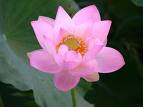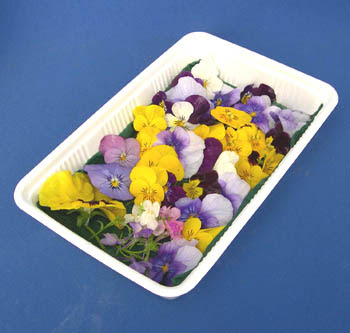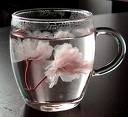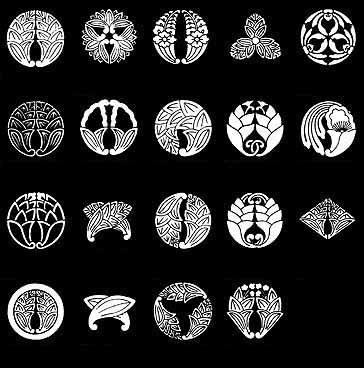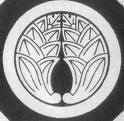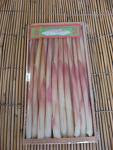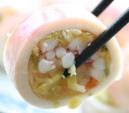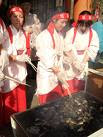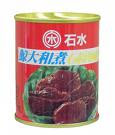::::::::::::::::::::::::::::::::::::::::::::::::::::::::::::::::::::::::::::::::::::::::::::::::::::
Sweet potatoe (satsuma imo)
***** Location: Japan
***** Season: various
***** Category: Plant
*****************************
Explanation
Ipomoea batatas
Batate., satsumaimo, satsuma-imo 薩摩芋, サツマイモ
potato from Satsuma (old name for Kagoshima)
sweet potatoe
kigo for mid-summer
flower of the sweet potato
satsumaimo no hana 甘藷の花 (さつまいものはな)
薩摩芋の花(さつまいものはな)
kansho no hana 甘藷の花(かんしょのはな)
kigo for mid-autumn
satsumaimo 甘藷 さつまいも sweet potato
autumn of the sweet potatoe, imo no aki 甘藷の秋(いものあき)
imo 藷(いも), imo 甘藷(いも),
"Chinese potatoe", karaimo 唐藷(からいも)
"Okinawa potatoe", Ryuukyuu imo 琉球薯(りゅうきゅういも)
"Satsuma potatoe", satsumaimo 薩摩薯(さつまいも)
"island potatoe" shima imo, shimaimo 島いも(しまいも)
bansho 蕃薯(ばんしょ),koosho 紅薯(こうしょ)
digging up sweet potatoes 甘藷掘(いもほり)imo hori
field of sweet potatoes, imo batake 甘藷畑(いもばたけ)
vines of sweet potatoes, imozuri 藷蔓(いもづる)
dried sweet potatoes, hoshiimo, hoshi-imo 干藷(ほしいも)
:::::::::::::::::::::::::::::::::::::::::::::::::::::::::::::::::::::::::::::::::::::::::::::::::::
. Tanegashima Annoo Imo 種子島あんのう芋 / 安納芋
mitsuimo, mitsu imo 蜜芋 "honey sweet potato"
:::::::::::::::::::::::::::::::::::::::::::::::::::::::::::::::::::::::::::::::::::::::::::::::::::
The student of European Knowledge (rangaku), Aoki Konyoo あおきこんよう【青木昆陽 1698~1769】from Satsuma studied the nutritious value of these potatoes and thus saved the people from starving during the Edo perod.
. . . CLICK here for Photos !
He was therefore called "Doctor Sweet Potato", 'Master Sweet Potato' (kansho sensei) かんしょせんせい【甘藷先生】.
. Aoki Konyoo 青木昆陽 Memorial .
In Fudōdōchō, Chiba 不動堂町 千葉県
Harvesting sweet potatoes
:::::::::::::::::::::::::::::::::::::::::::::::::::::::::::::::::::::::::::::::::::::::::::::::::::


Dishes with sweet potatoes
satsuma imo ryoori さつま芋料理
daigakuimo 大学芋 candied sweet potatoe
. . . CLICK here for Photos !
kandierte Süßkartoffel
imokenpi いもけんぴ sweet potatoe sticks
a deep/fried crunchy snack, also sold in packets.
. . . CLICK here for Photos !
Recipe
:::::::::::::::::::::::::::::::::::::::::::::::::::::::::::::::::::::::::::::::::::::::::::::::::::
kankoro かんころ 甘古呂
sweet potatoes are cut into circles of about 1 cm thickness and dried in the sun (and hopefully some cold wind from the sea, as in Shodoshima, Kagawa). Since the rings of potatoes roll around koronkoron, the name was given to this food.
The dry sweet potatoes are grind to flour in a stone grinder. The flour is used to prepare various dishes. This was a way to preserve the sweet potatoes for winter.
In Shodoshima there is almost no rice grown and people used sweet potatoe dishes instead. The island was also called "Sweet potatoe island さつまいもの島".
kankoro soba かんころそば noodles of sweet potatoe flour
from Mito peninsula, Shodoshima 三都半島(みと)
The skin is also used for making the flour and the final product looks slightly brown. 70% kankoro flour, 30% wheat flour is mixed. Dashi is made from iriko sardines.
The noodles are eaten with a bit of ginger and spring onion cuts.
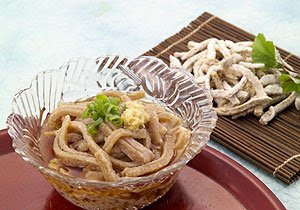
kankoro dango かんころ団子 / かんころだんご dumplings
imodango イモ団子
They were formed by the mother with her hands only and showed the imprints of her fingers.
. . . CLICK here for Photos !
. . . . . one more dish from Shodoshima
satsumaimo no tsuru no tsukudani
さつまいもの蔓(つる)の佃煮
boiled vines of the sweet potatoe
The vine was also used as a toy for girls, they prepared earrings out of it by tearing about 6 small bits out of one vine, letting it hang on one thin fiber connected to the vine.
After the war, anything was used to eat, so the vines of the sweet potatoes in this area were simmered with soy sauce and kombu. Today the tsukudani makers take pride in their work, using the best konbu from Rausu and Rishiri off Hokkaido and a special soy sauce (saishikomi) from the island.
Just blending the ingredients for about two hours by hand in huge pots with a special ladle takes a few years to learn.
A special finely chopped tsukudani for children can be eaten with a raw egg on rice (tamagokake gohan 卵掛けご飯), a simple but delicious dish.
Tsukudani is also served on toast on the island, with a bit of mayonaise or cheese: tsukudani toast 佃煮トースト.
. . . CLICK here for Photos !
kankoromochi kankoro mochi かんころもち(甘古呂餅)
speciality of Goto Retto Islands, off Nagasaki
These mochi are not so hard and have a green color.
yomogi or sesame was also added to the mix.
. . . CLICK here for Photos !
:::::::::::::::::::::::::::::::::::::::::::::::::::::::::::::::::::::::::::::::::::::::::::::::::::
imodango, imo dango いも団子 / さつま芋団子 / 芋団子
kara imodango からいもダンゴ
dumplings from sweet potatoes
They can be yellow or from purple satsumaimo. The potatoes are cooked and made to a mash in a suribachi, with a little dango flour added. Then salt and a lot of zarame raw suger is added to the imo dango 芋だんご.

They are wrapped in leaves of sane no ha さねの葉, which have a faint fragrance of pepeprmint.
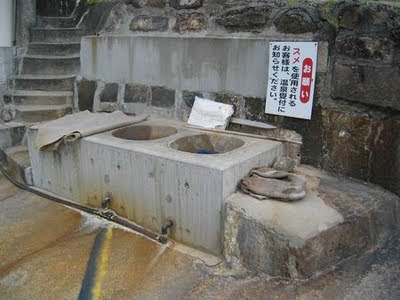
The whole dumpling is then put into a SUME スメ, a hot steamer from the local underground hot steam of the Unagi onsen 鰻温泉 hot spring. Each home has its own "sume steamer" outside, some even use the hot steam indoors as a kind of floor heating.
. . . CLICK here for Photos of Unagi Hotspring!
The flat dumplings are enjoyed together with friends or neighbors, as a snack during field work and on the sekku festivals in Spring.
Speciality from Ibusuki town いぶすき【指宿市】.
安納芋 Annoo imo from Kagoshima
CLICK here for PHOTOS !
. WASHOKU
Regional Dishes from Kagoshima (Satsuma)
:::::::::::::::::::::::::::::::::::::::::::::::::::::::::::::::::::::::::::::::::::::::::::::::::::
keeki 薩摩芋のケーキ cake with sweet potatoes
see photo above
kinpira, satsumaimo no kinpira 牛蒡と薩摩芋のきんぴら
simmered in soy sauce with burdock
. . . CLICK here for Photos !
Naruto Kintoki satsuma imo 鳴門金時 サツマイモ
Naruto sweet potatoes from Tokushima
. . . CLICK here for Photos !
Cheese cake with sweet potatoes
::::::::::::::::::::::::::::::::::::::::::::::::::::::::::::::::::::::::::::::::::::::::::::::::::::
nettabo ねったぼ dumplings from mashed sweet potatoes and mochigome rice
Sprinkled with kinako powder.
Kagoshima
It takes some time to prepare, but now even some schools are serving this to revive the local food traditions.
. . . CLICK here for Photos !
satsumazuke さつま漬け pickled sweet potatoes
from Kagoshima
tenpura てんぷら、天婦羅
Tempura with slices of sweet potatoes
*****************************
Worldwide use
*****************************
Things found on the way
kuwazuimo, kuwazu imo くわずいも (食わず芋)
"potato not to be eaten"
Alocasia oddora
Found in Shikoku on Ashizuri Misaki, flowers in june/july. Has poison and can not be eaten.
Maybe brought by currents from the lost continent Sundaland スンダランド.
*****************************
HAIKU
芋団子汗の童べ膝に肩に
imodango ase no warabe hiza ni kata ni
sweet potato dumplings -
(I place) the swetting baby on my knees
on my shoulder
Hosoya Genji 細谷源二 (1906 - 1970)
:::::::::::::::::::::::::::::::::::::::::::::::::::::::::::::::::::::::::::::::::::::::::::::::::::::
The mountain's sorrows
the sweet potato digger
can readily tell
Matsua Basho (1644-1694)
Tr. ??
from The Knapsack Notebook
source : www.soupsong.com
此山のかなしさ告よ野老掘
kono yama no kanashisa tsuge yo tokoro-hori
Basho at Temple Jingu-ji
at temple 伊勢の菩提山(ぼだいせん)神宮寺. This temple has been founded by waka-poet and priest Saigyo, but has fallen to ruin when Basho visited.
This seems the Japanese to go with it, but it is about the
tororo potato, yama-imo, Dioscorea opposita, a kind of YAM.
another Japanese version is this:
山寺の悲しさ告げよ野老掘り
yamadera no kanashisa tsugeyo tororo hori
tell us about
the sad fate of this mountain temple -
digger of yam
Matsuo Basho 松尾芭蕉
yamadera, a temple in the mountains 山寺
tororoimo, tororo imo とろろ芋
*****************************
Related words
***** WASHOKU : INGREDIENTS
:::::::::::::::::::::::::::::::::::::::::::::::::::::::::::::::::::::::::::::::::::::::::::::::::::::::::::::::::::::::::::
[ . BACK to DARUMA MUSEUM TOP . ]
[ . BACK to WORLDKIGO . TOP . ]
:::::::::::::::::::::::::::::::::::::::::::::::::::::::::::::::::::::::::::::::::::::::::::::::::::::::::::::::::::::::::::
